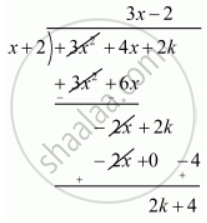Advertisements
Advertisements
Question
For what value of k, is −2 a zero of the polynomial 3x2 + 4x + 2k?
Solution
We know that if `x = a` is zero polynomial then `x-a` is a factor of `f(x)`
Since - 2 is a factor of `f(x)`.Therefore `x+2` is a factor of `f(x)`
Now, we divide`f(x) = 3x^2 + 4x + 2x ` by `g(x)=x + 2` to find the value of k

Now, Remainder = 0
`2k +4=0`
`2k = -4`
`k = (-4)/2`
`k = -2 `
Hence, the value of k is `-2 `
APPEARS IN
RELATED QUESTIONS
If x = 1 is a zero of the polynomial f(x) = x3 − 2x2 + 4x + k, write the value of k.
Give an example of polynomials f(x), g(x), q(x) and r(x) satisfying f(x) = g(x), q(x) + r(x), where degree r(x) = 0.
For what value of k, −4 is a zero of the polynomial x2 − x − (2k + 2)?
If zeros of the polynomial f(x) = x3 − 3px2 + qx − r are in A.P., then
If Q.No. 14, c =
Which of the following is not the graph of quadratic polynomial?
The below picture are few natural examples of parabolic shape which is represented by a quadratic polynomial. A parabolic arch is an arch in the shape of a parabola. In structures, their curve represents an efficient method of load, and so can be found in bridges and in architecture in a variety of forms.




In the standard form of a quadratic polynomial, ax2 + bx + c, a, b and c are:
The below picture are few natural examples of parabolic shape which is represented by a quadratic polynomial. A parabolic arch is an arch in the shape of a parabola. In structures, their curve represents an efficient method of load, and so can be found in bridges and in architecture in a variety of forms.




The graph of x2 + 1 = 0
The value of the polynomial 5x – 4x2 + 3, when x = –1 is ______.
Classify the following as a constant, linear, quadratic and cubic polynomials:
1 + x + x2
